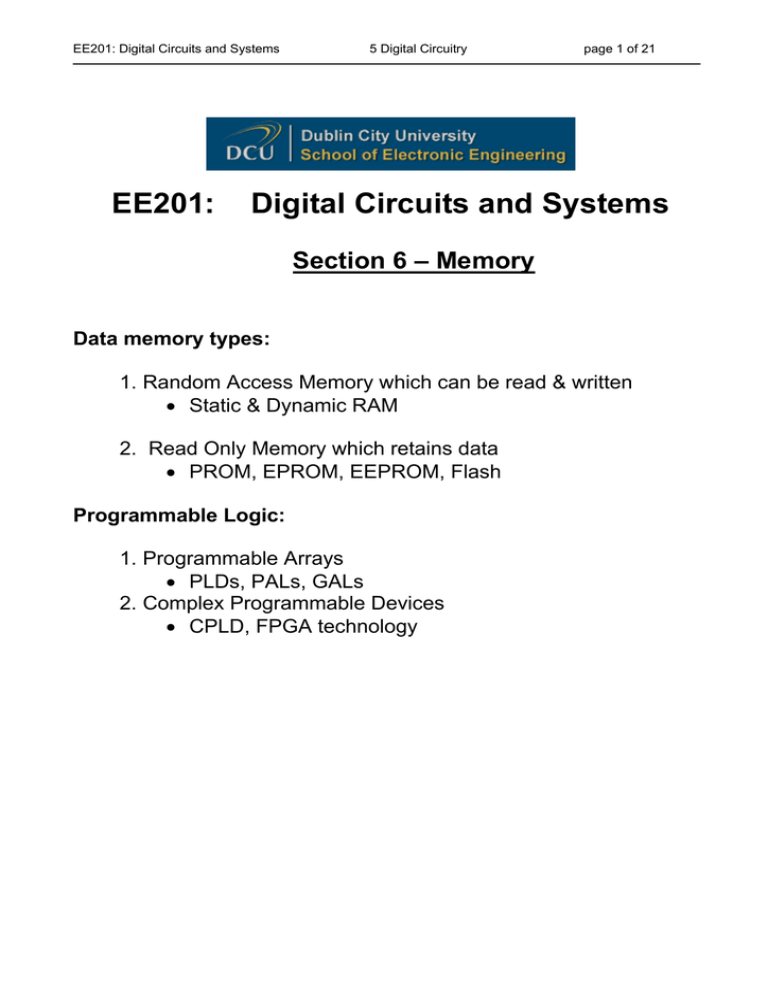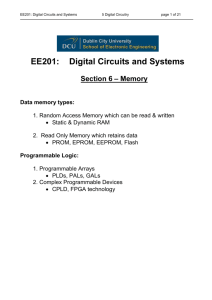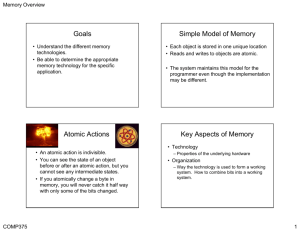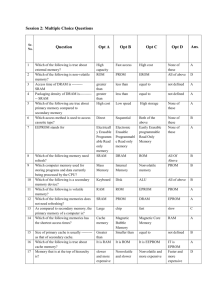EE201: Digital Circuits and Systems
advertisement

EE201: Digital Circuits and Systems EE201: 5 Digital Circuitry page 1 of 21 Digital Circuits and Systems Section 6 – Memory Data memory types: 1. Random Access Memory which can be read & written • Static & Dynamic RAM 2. Read Only Memory which retains data • PROM, EPROM, EEPROM, Flash Programmable Logic: 1. Programmable Arrays • PLDs, PALs, GALs 2. Complex Programmable Devices • CPLD, FPGA technology EE201: Digital Circuits and Systems 5 Digital Circuitry page 2 of 21 6.1 Static RAM (SRAM) • Static Random Access Memory • Static: Data value is retained as long as VDD is present. • Random Access: Any location can read at a point in time.(Doesn’t need sequential addresses) SRAM can be built using either: • D-type latch • 6-transistor CMOS RAM cell 6.1.1 D-type Latch • Used for building CPU registers, etc • Derived from inverted S-R flipflop /S 0 0 1 1 Inverted S-R flip-flop: /R 0 1 0 1 Q’ X 1 0 Q D-type latch E 0 0 1 1 D 0 1 0 1 /S 1 1 1 0 /R 1 1 0 1 Q’ No Change No Change 0 1 When the Enable line is zero (En=0) • /S = /R = 1 and the inverting SR flipflop retains its previous value. When the enable line is high (En=1) • The value of data line D is latched into the flipflop. EE201: Digital Circuits and Systems 5 Digital Circuitry page 3 of 21 Each BIT would need 16 transistors (NAND gate = 4 transistors) • For large SRAM modules not very efficient. o 1-MB SRAM -> 8-Mb -> 128 Million transistors 6.1.2 Edge Triggered D-type Register • For use with a combinational circuit it is more important to have devices respond to clock edges. o D-type Latch ‘works’ when En=1 or En=0 o D-type Register ‘works’ when En is rising or falling. Edge triggered flip-flop for use in synchronous circuits. • Uses 2 D-type transparent latches(Red Boxes) and 2 NOT gates When the clock is low (Clk=0) • The first D-type latch is ON, • The value of D latched into first flipflop. When clock goes high (Clk=1) • The first D-type latch switches OFF and the second D-type latch is enabled. • The output of latch 1 propagates through the second flipflop to the output. Value of output is retained until next rising edge Falling clock edges: Remove leftmost inverter from the circuit. EE201: Digital Circuits and Systems 5 Digital Circuitry page 4 of 21 6.1.3 6-Transistor Cell (Cross Coupled Inverter) • For larger SRAM modules the above circuit is not very efficient o Transistor count per bit is too high TO READ: • BIT lines are charged high • Enable line WL is pulled high, switching access transistors M5 and M6 on` • If value stored in /Q is 0, value is accessed through access transistor M5 on /BL. • If value stored in Q is 1, charged value of Bit line BL is pulled up to VDD. • Value is ‘sensed’ on BL and /BL. TO WRITE: • Apply value to be stored to Bit lines BL and /BL • Enable line WL is triggered and input value is latched into storage cell • BIT line drivers must be stronger than SRAM transistor cell to override previous values While Enable line is held low, the inverters retain the previous value Could use tri-state WE line on BIT to drive into specific state. Transistor count per bit is only 6 + (line drivers & sense logic) EE201: Digital Circuits and Systems 5 Digital Circuitry page 5 of 21 6.1.4 Addressed SRAM • Can view RAM as N-bit by M-word black box: o N input lines DIN o N output lines DOUT A o A address lines (2 = M) A o WE write enable line WE 6.1.4.1 Single SRAM Bit When A = 0, • Latch Enable is off. o Data cannot be written into the D-type latch o DOUT = 0. When A = 1 • Latch is Enabled o If W = 1 (Data-Write) • Data at DIN can be written into the D-type latch • Output gate is enabled o IF W = 0 • New value on DIN is not stored. • Output gate is enabled. • Not very efficient since 1-bit address line can access 2 memory locations. • This memory is 1-bit X 1-word RAM o Stores one 1-bit data value EE201: Digital Circuits and Systems A 0 0 0 0 1 1 1 1 5 Digital Circuitry W DI 0 0 0 1 1 0 1 1 0 0 0 1 1 0 1 1 page 6 of 21 FlipFlop Out DO Q(t-1) 0 Q(t-1) 0 Q(t-1) 0 Q(t-1) 0 Q(t) Q(t) Q(t) Q(t) 0 0 1 1 6.1.4.1 1-bit X 2-word SRAM DI W 1-Bit Memory Cell 0 A DataOut DI DI W W A1 A 1-Bit Memory Cell 1 When address bit AI = 0 • Cell1 is disabled and Cell0 is enabled o IF W = 1 : Value of DIN is written to cell0 o IF W = 0 : Data out is Cell0 OR 0 When address bit AI = 1 • Cell0 is disabled and Cell1 is enabled o IF W = 1 : Value of DIN is written to cell1 o IF W = 0 : Data out is Cell1 OR 0 • Only 1 cell can be active at one time • Output line is always driven by one cell o Important for shared bus EE201: Digital Circuits and Systems 5 Digital Circuitry page 7 of 21 6.1.5 4-bit X 16-word SRAM DI1 A4 A3 A2 A1 a 0 . . . . . . a 15 A DI2 DI3 DI4 DI DO CS Chip Select W => to all cells DO1 DO2 DO3 DO4 When CS = 1 AND A4 A3 A2 A1 = 0000 • Address decoder decodes A4-A1 to o 1000000000000000 (a0 = 1, a1-a15 = 0 • Data at DI1 DI2 DI3 DI4 is written to address 0 when W = 1 • If W = 0, No new data is stored and address0 drives the output bus • Contents of memory address 0 appear at output Address decoder maps input address bits to row control signals • Should only set one bit for every possible input o 2A states where A is the number of address lines The CS (chip select) line allows the memory to be doubled with only one inverter [+ OR gates]. EE201: Digital Circuits and Systems 5 Digital Circuitry page 8 of 21 6.1.5 Tri-State Outputs: • In previous examples, one location is enabled during each operation which can drive the output bus. • If RAM is on shared bus, the RAM cannot be allowed to drive the bus at all times • Must have method of removing RAM from bus • Solution is to use Tri-State logic A1 A2 A3 A4 DI0 . . . .DI3 CS DO0 . . .DO3 A1 A2 A3 A4 A1 A2 A3 A4 A5 CS DI0 . . . DI3 DO0 . . . DO3 Data Bus • Outputs from each cell are tri-state outputs. • When not active the outputs are in high impedance. • Can either use CS line to control when Hi-Z or another ‘global’ memory signal which controls the output OE • Allows both other RAM cells and other devices to control data bus EE201: Digital Circuits and Systems 5 Digital Circuitry page 9 of 21 6.2 Dynamic RAM (DRAM) • SRAM requires a number of transistors per bit o Difficult to cost-effectively scale for larger memories • DRAM utilises MOSFET capacitance to store data bit o Transistor per bit cost is approx 1 • Si02 insulates gate and substrate o Creating dielectric capacitor between gate and substrate • Data bit is stored in this capacitance • Each bit now only requires 1 MOSFET per bit. o However the charge stored in cell dissipates over time and must be recharged over time to avoid corruption DRAM Refresh o Must read data bit and write value back to cell. o JEDEC standardises DRAM row refreshes at least every 64 ms. All bits in row must be refreshed. o Dedicated hardware control DRAM refresh Refresh is transparent to user • Above 64 Kbits, DRAM more economic than SRAM logic o Even with refresh. EE201: Digital Circuits and Systems 5 Digital Circuitry page 10 of 21 Write Operation X 0 X 1 1 Y X 0 1 1 Data I/O X X 0 1 C 0 1 Read Operation X 0 X 1 1 Y X 0 1 1 Data I/O X X 0 1 C C C 0 1 6.2.1 DRAM Organisation • DRAM is organised as “row by column” matrix. o Matrix stores n 1-bit words o N is determined by the number of address lines available • Each matrix is parallelised to create word size memories o i.e : 8 parallel 4Kx1-bit DRAM matrices creates an 4K * 8-bit RAM module EE201: Digital Circuits and Systems 5 Digital Circuitry page 11 of 21 Example An 8x8 array forms a 64 x 1 dynamic RAM • The row and column select logic are comprised of address decoders. o 8-rows and 8-columns need 3-address bits each. • Above block is 64x1-bit DRAM • Diagram omits but matrix has 1 data I/O line. o Row and Column address control which bit is active EE201: Digital Circuits and Systems 5 Digital Circuitry page 12 of 21 This block can be parallelised to create larger data word Each bit of data word is read/wrote in parallel Example 2 How to build 4k X 1 dynamic RAM? Step 1: How to arrange row & columns Step 2: 64 x 64 array provides 4096 (4K) bits Step 4: How many address lines needed for 64-line decoder? 26 = 64, Need 6 row lines and 6 column lines EE201: Digital Circuits and Systems 5 Digital Circuitry page 13 of 21 Pin Requirements • 12 Address Bits: 6-bit for row and 6-bits for column • 3 Control Bits: WE , CS and OE • 1 Data I/O bit bus • VDD and GND Entire IC will require 18 pins 6.2.3 Multiplexed Address Lines • To further reduce cost, DRAM uses multiplexed address o 4K x 1 = 12 Address lines o 16M x 1 = 24 Address lines Since column address is independent of row address o We can provide row address and then column address o If 12-bit address bus is multiplexed we can address 16M DRAM with only 2 additional lines (RAS and CAS) o RAS : Row Address Strobe o CAS : Column Address Strobe Multiplexed Address, Step by Step: Step 1: Latch out 12 row address bits Step 2: Strobe RAS line which causes DRAM to latch in row address Step 3: Wait until you are sure it has been registered and latch out column address bits Step 4: Strobe CAS line which causes DRAM to latch in column address Step 5: Wait some period of time and read/write to data bus EE201: Digital Circuits and Systems 5 Digital Circuitry page 14 of 21 6.2.4 DRAM Timing • DRAM module is asynchronous o Timing depends on how long it takes to respond to each operation. DRAM cannot be read as fast (or as easy) as SRAM EE201: Digital Circuits and Systems 5 Digital Circuitry page 15 of 21 6.3 Read Only Memory (ROM) • Disadvantage with RAM (static or dynamic) is that the contents of the memory are lost when power is removed. Volatile memory: Content lost when VDD is removed (RAM) Non-Volatile memory: Data is retained after VDD is gone. ROM Types: 1) ROM : Most basic memory 2) PROM : Additional functionality on ROM 3) (UV) – EPROM : Can be reprogrammed 4) EEPROM : Can be reprogrammed (easier than EPROM) 5) Flash : Current technology (easier again) 6.3.1 ROM o Most basic type of ROM is factory-programmed diode matrix EE201: Digital Circuits and Systems 5 Digital Circuitry page 16 of 21 • The diode can be replaced by a multiple emitter transistor for each data word. o During manufacture, a diode is placed at those connections which are required by the customer. o Complete transistor array is programmed via fabrication mask o Those connections without diode cannot be changed later and vice-versa Memory is read-only ROM is economic when several thousand devices are needed. 6.3.2 Programmable ROM (PROM) • ROM device is factory-programmed device o Need to tell fab plant which connections to make/skip • More useful solution would be to allow customer to program device in the field. o Place diode at every junction with nichrome fusible link in series. o Any link can be blown by selecting its address and applying a high voltage to its data output o Once fuse has been blown it cannot be repaired. Memory is read-only Advantage over ROM • Device is ‘field-programmable’: o Customer can buy a blank PROM to programme o Manufacturer can made identical PROM for every customer, reducing cost Disadvantages over ROM • Need 2 voltages: o Operating voltage o Programming voltage EE201: Digital Circuits and Systems 5 Digital Circuitry page 17 of 21 6.3.3 Erasable PROM (EPROM) • An EPROM can be programmed in a similar manner to a PROM • Each diode/fuse is replaced by 2-Gate MOS transistor • High programming voltage injects electrons into transistor • Process can be reversed by exposing device to UV light o UV lightwave reforms conductive channel Advantage over ROM/PROM • Device is field programmable plus the code can be re-written at a later date Disadvantages over ROM/PROM • Still need 2 voltages • Quartz crystal is expensive. 6.3.4 Electrically Erasable PROM (EEPROM) • Unlike EPROM, no UV light is required to erase memory. o Thin insulator layer allows voltage to erase • Program/Erase voltage generated on-chip o Single VDD line required. Advantage over ROM/PROM/EPROM • Can be reprogrammed easier • Only single power supply needed Disadvantage over ROM/PROM/EPROM • Thin gate insulator layer is damaged by erase/write operations o New EEPROM device has 1,000,000 cycles EE201: Digital Circuits and Systems 6.3.5 Flash PROM (FLASH) 5 Digital Circuitry page 18 of 21 [http://en.wikipedia.org/wiki/Flash_memory] Flash memory stores information in an array of memory cells made from floatinggate transistors. The floating gate may be conductive (typically polysilicon in most kinds of flash memory) or non-conductive (as in SONOS flash memory) The ångström or angstrom (symbol Å) is equal to 0.1 nanometre or 1 × 10−10 metres. EE201: Digital Circuits and Systems 5 Digital Circuitry page 19 of 21 • Flash memory is improvement on EEPROM technology • Lower operational voltage, program voltage Flash Disadvantages • As gate insulator is thinned, the number of times it can be written is reduced. Flash might have 1,000,000 write cycles • Entire block(or page) must be erased at one time in flash,(byte can be erased in EEPROM) EE201: Digital Circuits and Systems 5 Digital Circuitry page 20 of 21 All ROM memory is quite slow compared to DRAM and SRAM • Typically try to use it to store code/data but execute code and manipulate data in RAM 6.3.5 ROM’s for Combinational Logic • A suitably programmed ROM can generate any combinational logic function. • Number of inputs ≤ Number of address lines • Number of outputs ≤ Number of bits. Example • Converter from 3-bit binary to 7-segment display code. (0 = on, 1 = off) C 0 0 0 0 1 1 1 1 B 0 0 1 1 0 0 1 1 A 0 1 0 1 0 1 0 1 a 0 1 0 0 1 0 1 0 b 0 0 0 0 0 1 1 0 An 8-word by 7-bit ROM is needed. c 0 0 1 0 0 0 0 0 d 0 1 0 0 1 0 0 1 e 0 1 0 1 1 1 0 1 f 0 1 1 1 0 0 0 1 g 1 1 0 0 0 0 0 1 EE201: Digital Circuits and Systems 5 Digital Circuitry page 21 of 21 Characteristics of the various memory types Type Volatile? Writeable? Erase Size Max Erase Cycles Cost (per Byte) Speed SRAM Yes Yes Byte Unlimited Expensive Fast DRAM Yes Yes Byte Unlimited Moderate Moderate Masked ROM No No n/a n/a Inexpensive Fast PROM No Once, with a device programmer n/a n/a Moderate Fast EPROM No Yes, with a device programmer Entire Chip Limited (consult datasheet) Moderate Fast EEPROM No Yes Byte Limited (consult datasheet) Expensive Fast to read, slow to erase/write Moderate Fast to read, slow to erase/write Expensive (SRAM + battery) Fast Flash No Yes Sector Limited (consult datasheet) NVRAM No Yes Byte Unlimited




